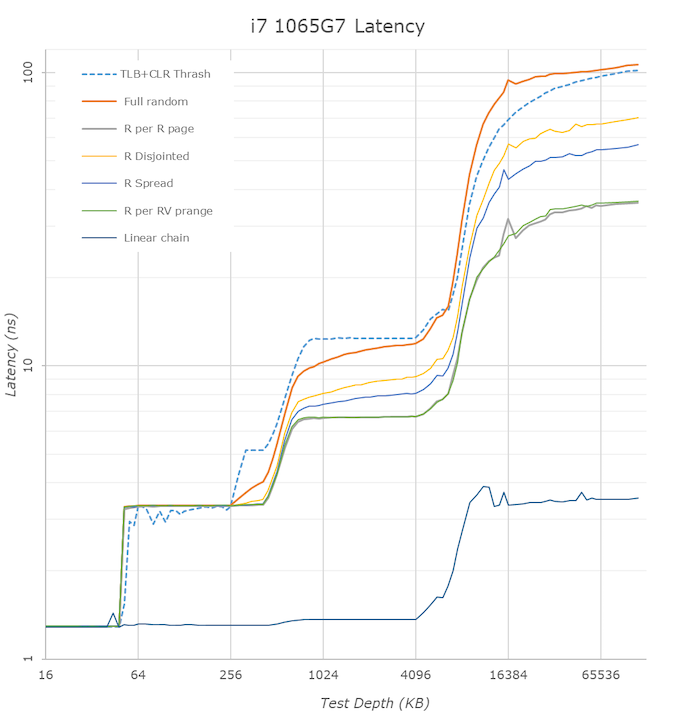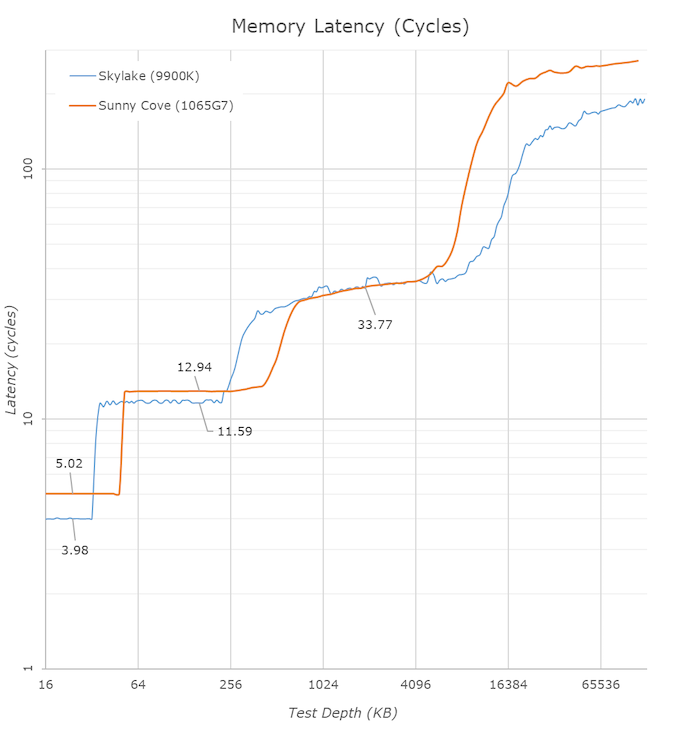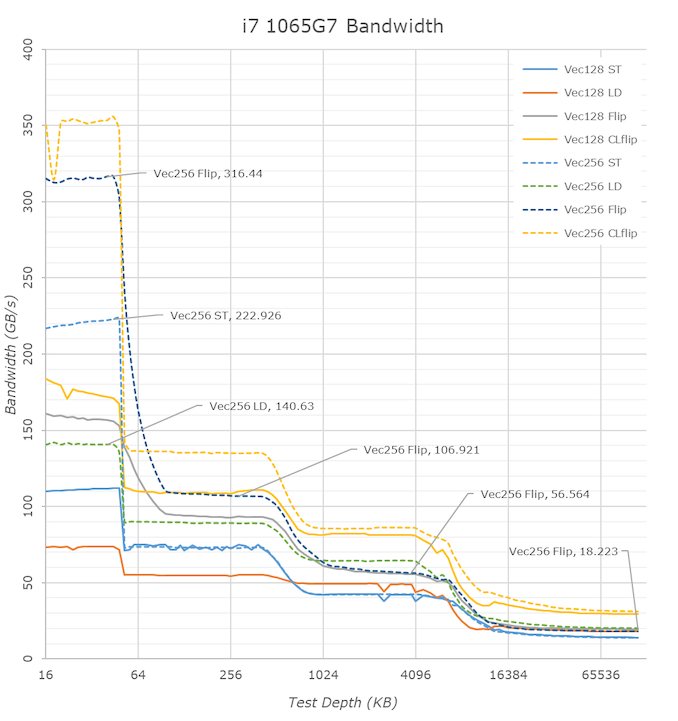The Ice Lake Benchmark Preview: Inside Intel's 10nm
by Dr. Ian Cutress on August 1, 2019 9:00 AM EST- Posted in
- CPUs
- Intel
- GPUs
- 10nm
- Core
- Ice Lake
- Cannon Lake
- Sunny Cove
- 10th Gen Core
Cache and TLB Updates
One of the biggest changes in the new Sunny Cove core is the cache hierarchy. Throughout most of the last decade, Intel has kept the same cache configuration among its server cores with very few changes, aside from improving the micro-op cache through Sandy Bridge today, but with Sunny Cove, we get some key updates.
From our microarchitecture disclosure article, we know that Sunny Cove brings with it an increased L1 data cache, as well as a doubled L2 cache, from Skylake. With this comes more associativity as well.
| Core Cache Comparison | ||||||
| Sunny Cove |
AnandTech | Cannon Lake |
Skylake | Sandy Bridge |
AMD Zen 2 |
|
| 48 KB 12-way |
L1-D | 32 KB 8-way |
32 KB 8-way |
32 KB 8-way |
32 KB 8-way |
|
| 32 KB 8-way |
L1-I | 32 KB 8-way |
32 KB 8-way |
32 KB 8-way |
32 KB 8-way |
|
| 512 KB 8-way |
L2 | 256 KB 4-way |
256 KB 4-way |
256 KB 8-way |
512 KB 8-way |
|
| 2 MB 16-way |
L3/core | 2 MB 16-way |
2 MB 16-way |
2MB 16-way |
4 MB 16-way |
|
| 2304 | uOp Cache | 1536 | 1536 | 1536 | 4096 | |
I’ve also included the size of the micro-op cache in this comparison, because we understand that the L1-I and the micro-op cache are typically located next to each other in the die design – increasing the size of one typically means limiting the size of the other, however given that both of them work to accelerate the same types of data, it is important to find the right balance: AMD for Zen 2 decided to halve the L1-I and double its associativity, and then double the micro-op cache from 2k to 4k entries. For Sunny Cove, Intel has increased the L1-D by 50%, but also increased the micro-op cache by 50%, taking advantage of the second generation 10nm process.
In the above latency graph comparison, we can notably see the new increased cache capacities. The L1’s increase from 32KB to 48KB is well visible, as well as the L2 increase from 256KB to 512KB.
On the part of the L2 it’s interesting to see that again the new core’s TLB structures don’t quite cover the whole capacity of the L2 and that’s why the latter half of the L2 has worse access latencies for L1D TLB miss patterns.
L3 latencies look similar, however we’ll dwell into that just in a bit. The DRAM latencies of course are apples and oranges in this case as Intel’s new LPPDR4X memory controller in the new ICL part doesn’t have a counter-part we can compare to, but as expected the memory latency is notably worse than a desktop part so no big surprises there.
What’s rather disappointing however is that we’re not really seeing any kind of change to the prefetchers and our access patterns between the two microarchitectures look identical. We had expected Intel to improve in this regard, but alas it seems, at least for our test cases, there’s been no improvements.
One of the major balancing acts with cache sizes is also cache latency. The bigger the cache, the longer it takes to retrieve data from it – increasing associativity can do this as well. Intel for the longest time has cited a 4-cycle latency to its L1 cache, and a 12-cycle latency to its L2 cache. This changes, in quite a substantial way.
| Core Cache Latency (in cycles) | ||||||
| Sunny Cove | AnandTech | Cannon Lake |
Skylake | Sandy Bridge |
AMD Zen 2 |
|
| 5 | L1 | 4 | 4 | 4 | 4 | |
| 13 | L2 | 12 | ~12 | 12 | 12 | |
| 30-36 | L3 | 26-37 | 34 | |||
Due to the increase in the L1 cache, that 4-cycle latency is now a 5-cycle latency. Intel is hoping that its double L1 store bandwidth will help hide that latency, however adding 20% latency onto every data fetch is a heavy hit to take. This is why a lot of the rest of the core is also beefed up, so work can still continue to cover for this extra cycle. It is worth noting that Intel’s Atom cores in the past had an L1 latency of 3 cycles, however they have also since moved to 4-cycle.
The L2 also changes, from 12 cycles to 13 cycles. You can’t double a cache for free, and it is interesting to note here that now AMD and Intel share the same L2 cache size and the same associativity, however AMD has a cycle advantage on Intel. This has a knock on effect for L3 cache latency too, which has increased from ~26-37 cycles to ~30-36 cycles on Intel, from Skylake. The latency here isn’t uniform because the cache isn’t uniform, and accessing non-local L3 slices comes with a latency penalty, as say opposed to AMD’s uniform latency L3.
One of the biggest additions Intel was keen to make in our Sunny Cove microarchitecture disclosure is the increase in the L1 bandwidth. Based on our testing, Skylake’s L1 data cache was capable of 2x32-byte read and 1x32-byte write per clock. For Sunny Cove this has increased, but it gets a bit more complicated. In one clock Sunny cove can perform 2x64-byte reads and either 1x64-byte write, or 1x32-byte write, or 2x16-byte writes. So both reads and writes, at peak, have doubled with bit width, with the write configurations being a bit more complex.
We can see the direct effects of the bandwidth change in our bandwidth tests. The L1 store bandwidth is extremely evident as it measures in at 222GB/s on the ICL part, while only reaching 139GB/s on the 28% higher clocked 9900K. If we normalise for frequency, we indeed see a doubling of the store bandwidth of the new core.
The L2 cache bandwidth looks unchanged from Skylake – the part here lags behind with an equal amount to the frequency difference. Surprisingly, the L3 bandwidth fares quite well here and is almost at parity to the desktop 9900K even though the frequency difference. The DRAM bandwidth is inferior on the ICL mobile chip, but again that’s to be expected due to the apples and oranges DRAM architecture comparison.
Moving on to the TLB configurations, and it turns out that Intel has moved where this data is stored. This data is typically stored in CPUID.02h, however it is now found in CPUID.18h, and the info between different page sizes and capabilities is now given as subdivisions. The TLBs look as follows, and broken down into configurations:
| Sunny Cove TLB | |||
| AnandTech | Type | Entries | Associativity |
| L1-D | 4K | 64 | 4-way |
| L1-D | 2M | 32 | 4-way |
| L1-D | 1G | 8 | full |
| L1-I | 4K+2M | 8 | full |
| L1-I | 4K+2M+1G | 16 | full |
| L2 | 4K+2M | 1024 | 8-way |
| L2 | 4K+1G | 1024 | 8-way |
This means that for 4K and 2M L1-I entries, there are a total 8+16 = 24 possible, but only 16 1G possible. For 4K L2 entries, there are 1024 + 1024 = 2048 entries possible, however only 1024 each of 2M/1G are possible. The peak numbers align with what Intel has told us in our microarchitecture disclosure, however it is good to dive into what is possible.













261 Comments
View All Comments
zodiacfml - Friday, August 2, 2019 - link
Yes and No. Intel at 10nm should have made AMD nervous but products only at 4 cores, there is nothing or little benefit with 10nm. I reckon, AMD's 7nm mobile parts will mostly start at 6 cores.Kevin G - Thursday, August 1, 2019 - link
Those 3D particle movement tests seem to be too good to be true. There should be a gigantic jump due to an optimized AVX-512 code path and ICL's enhanced caching structure but it is beyond that in the comparison. I'm not actually suspecting the ICL system given the disclosures in the article (odd that the note about AVX-512 intrinistics for the 3DPM test is mentioned around SPEC compiler settings) but rather the other test systems. Where the Whisky Lake or Kaby Lake systems power or thermal constrained at all? On those Hauwei laptops, were you able to set their fan to a fixed 100% to match that of the ICL system?Ian Cutress - Thursday, August 1, 2019 - link
The AVX-512 tests were similar when we compared Cannon Lake to Kaby Lake at the same frequency. Against unoptimized SSE code, AVX-512 is killer.Kevin G - Friday, August 2, 2019 - link
Getting a bit more than double the performance from AVX2 vs. AVX-512 should be possible using some of the new Ice Lake extensions and the obvious doubling of SIMD width. But going from a score of 1802 in Whiskey Lake 25W to 9242 for Ice Lake 25W, over a factor of 5! Ice Lake would have to remove some other bottleneck that the 3DPM test hits really hard (division?).Looking back at your previous reviews ( https://www.anandtech.com/show/13400/intel-9th-gen... ), you can see a similar speed up from AVX-512 between the i9 9900K and the i9 7820X but that is explained from Skylake-X having both double the SIMD width and double the number of SIMD execution units. The client version of Ice Lake shouldn't have the same AVX-512 throughput as Sky Lake server.
CSMR - Thursday, August 1, 2019 - link
> the one area where Ice Lake excels in is graphics. Moving from 24 EUs to 64 EUs, plus an increase in memory bandwidth to >50 GB/s, makes for some easy reading.I don't understand the comparison here and in this article. If you say a high-end intel processor update excels in graphics, you should compare to previous high-end processors (e.g. i7-8559U with Iris Plus 655). These have 48EUs not 24 and have 128MB EDRAM at 100 GB/s unlike the Ice Lake.
I am very interested in how the best Ice Lake processors compare to the best previous-gen processors, not how they compare to mediocre previous-gen processors.
Could the article be updated with some appropriate comparisons?
eastcoast_pete - Thursday, August 1, 2019 - link
Agree on adding the best previous generation graphics to the comparison. Also, while the over 1 TFlops for the 64EU Gen 11 sounds (and is) impressive (within the Intel iGPU world) , didn't the 48EU with Crystal Well get close to that already?Rudde - Thursday, August 1, 2019 - link
The first apu with 1TFlops performance statement is full of asteriks. First, you have to exclude AMD; second, you have to exclude Intel Iris gpus with eDRAM.Phynaz - Thursday, August 1, 2019 - link
AMD mobile chips are hot garbageeva02langley - Friday, August 2, 2019 - link
Your opinion is not a fact... and it is garbage for real.Phynaz - Friday, August 2, 2019 - link
Hahaha. It’s a fact. It’s why they have 0% market share.